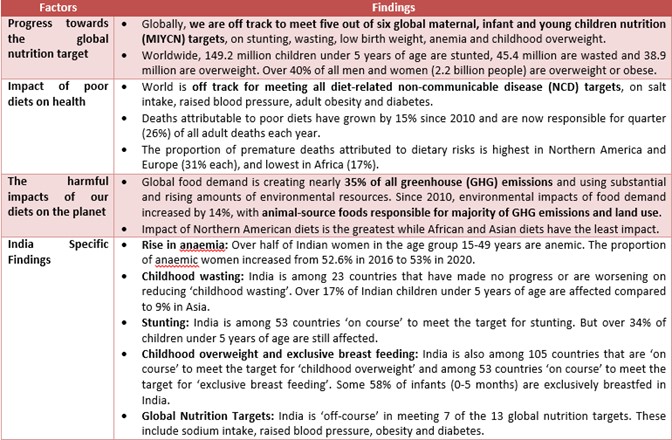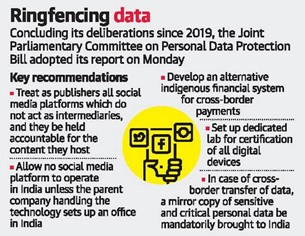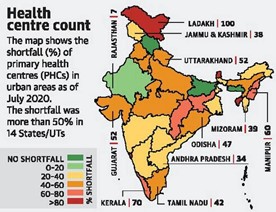Friday, 26th November 2021
Rationalization of the goods and services tax (GST) structure
In News
A rent study by the National Institute of Public Finance and Policy says that the Government can rationalise the GST rates without losing revenues.
Why GST rate structure needs rationalisation?
- Complicated Rate Structure: Currently, we have a four-slab rate structure-5%, 12%, 18% and 28%. Add to this, 0% exempt category and 3% on gold and additional cess charged on certain products, effectively makes GST a 7 tax-slab structure.
- As per a World Bank report, GST is one of the most complex with the second highest tax rate in the world among 115 countries which have a similar indirect tax system.
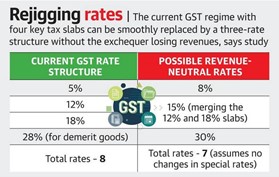
- Low collection: Collection from GST is much lower than expected and compensation requirements for states keep exceeding the collections from Compensation Cess.
- Lower Revenue Neutral Rate (RNR): The RNR prescribed at the time of implementation of GST was 15.3%. But the weightage average GST rate currently is only 11.6%.
- Low Starting GST Rate: The Reserve Bank of India (RBI) in its analysis in 2019 had said that the new tax regime started with a lower GST incidence of 14% instead of the prescribed revenue rate of 15.3%.
- Progressive Rate Cuts: When the GST was implemented in 2017, there were over 200 items which were in the 28% tax slab, but subsequently the rates on many of these items were cut to 18% or less. Currently, only 37 categories of items are in the 28% slab.
Implications
- Government failed to collect GST as much as it expected under Budget.
- The 15th Finance Commission noted that GST buoyancy during 2017-2020 was less than that of subsumed taxes during 2011-2017. And it cited that successive reduction in tax rates and the consequent compromise of the revenue neutrality of GST rates have affected the revenue performance.
- Moreover, exemptions under GST come with the cost of blocking input tax credit (ITC) and thus causing higher input tax for businesses.
Other Areas for reform
- 28 % category: There are some items in the 28% category that must be brought down to the general rate to help in the economic recovery process. The most important set of items relate to building and construction materials.
- Petroleum products: Petroleum products can be brought within the ambit of GST, not only to check spiralling prices but to minimise cascading and to improve competitiveness of the economy.
- Remove Exemptions: At present, as many as 148 items under the four-digit HSN classification, and having almost 50% weight in the consumer price index (CPI), have been kept in the exempted list. It is important to bring most of them within the ambit of GST.
- Tax compliance: Comprehensively cover legal services in the tax net and to ensure better tax compliance by professionals like doctors, architects and contractors.
- Reverse charge mechanism: It is important to expand the coverage by introducing the reverse charge mechanism. Reverse charge is a mechanism where the recipient of the goods or services is liable to pay GST instead of the supplier.
Sources:
Digital Banks: A Proposal for Licensing & Regulatory Regime for India
In News
NITI Aayog’s Paper “Digital Banks: A Proposal for Licensing & Regulatory Regime for India” has offered a template and roadmap for a Digital Bank licensing and regulatory regime for India.
What is a Digital Bank (DB)?
- A DB means Banks as defined in the Banking Regulation Act, 1949 (B R Act). However, DBs will principally rely on the internet and other proximate channels to offer their services and not physical branches.
- These entities will issue deposits, make loans and offer the full suite of services as provided under B R Act.
Context for the Case of Digital Banks in India: Financial Inclusion
- A broader Digital India revolution catalysed by PM Jan Dhan Yojana (PMJDY), India Stack, e-KYC and UPI led a paradigm shift in the way India interacted with and consumed financial services.
- Jan Dan-Aadhar-Mobile (JAM) trinity, biometric Aadhar system, UPI, DBT etc., made financial inclusion a viable reality for the citizens of India.
- India is also operationalizing its own version of “Open banking” through the Account Aggregator (“AA”) regulatory framework enacted by the RBI. It will catalyse credit deepening among under-served groups.
- However, credit penetration remains a public policy challenge, especially for MSMEs that contribute approx 30 % to the GDP, about 45% to manufacturing output, more than 40% of exports, while creating employment for a significant section of the population, which in terms of volume stands next to agricultural sector. This is hindering the development of conducive business environment for expansion of MSME sector.
Digital Banks: The Promise They Hold for India
- Incumbent commercial banks have inefficient business models as evidenced by high cost to income, and high cost to serve numbers.
- Banks and fintechs offering digital banking services (neo-banks) rely primarily on digital channels that organically have high efficiency metrics relative to incumbent commercial banks. Hence, they can be potentially effective channel to achieve social goals like serving under-banked small businesses, and enhancing trust among retail consumers.
- However, in the absence of a licensing regime for full-stack digital banks, fintechs offering the neo-bank proposition have improvised and adopted the front-end neo-banks model. But this model presents several challenges such as Limited Revenue Potential, Potential Obsolescence of the Partner Bank Core Banking System and High Cost of Capital & No Entry Barrier.
- Hence, creating a new licensing / regulatory framework for Digital Banks is being proposed.
Summary of Reforms Proposed by NITI Aayog
- Methodology for licensing and regulatory template: The Paper constructs an equal-weighted “Digital Bank Regulatory Index” comprising of 4 factors: Entry barriers; Competition; Business Restrictions and Technological Neutrality and maps the elements of these indices against the 5 benchmark jurisdictions of Singapore, Hong Kong, United Kingdom, Malaysia, Australia and South Korea.
- Digital Bank license: It recommends a two-stage approach – First issue a digital business bank license and then Digital (Universal) Bank license after policymakers and regulators have gained experience.
- Even with the Digital Business Bank license, it recommends following steps:
- Issue of a restrictedDigital Business Bank license (to a given applicant) (the license will be restricted in terms of volume/ value of customers serviced and the like).
- Enlistment (of the licensee) in a regulatory sandbox framework enacted by the RBI
- Issue of a “full-stack” Digital Business Bank license (contingent on satisfactory performance of the licensee in the regulatory sandbox including saliently, prudential and technological risk management)
- Focus on avoiding any regulatory or policy arbitrage and giving a level playing field.
Sources:
Bharat Gaurav scheme
In News
The Indian Railways has recently launched Bharat Gaurav Trains to promote and attract tourism business.
About the News
- The Bharat Gaurav trains will be operated by private players and run on theme-based circuits.
- The Railways, through this policy has liberalised and simplified a part of operations by offering operators the “Right of Use” of its rakes and infrastructure that was otherwise carried out mostly by the Indian Railway Catering and Tourism Corporation (IRCTC).
- While any entity can run these trains, including state governments, it is implied that the policy is targeted at tour operators.
What is the Bharat Gaurav policy?
- Who is eligible? Under the policy, any operator or service provider, or virtually anyone, can lease trains from Indian Railways to run on a theme-based circuit as a special tourism package.
- The operator has the freedom to decide the route, the halts, the services provided, and, most importantly, the tariff.
- What is the Tenure? The tenure of the arrangement is a minimum of two years and maximum of the codal life of the coach.
- What should the operators do? The operator will have to propose a similar business model (such as theme-based tourist trains like the Ramayana Express run by IRCTC that tours several places connected to Lord Ram) wherein it takes care of local transport, sightseeing, food, local stays, etc. along with operating the trains.
- Role of the Railways: There will be a special unit created in each zonal railway to process the applications of various operators and also handhold applicants. This provides the operators a single-window for all their needs.
- What can the operators do within the contract? The operator can:
- Carry out its own furnishings of the interiors of the trains without tinkering or dismantling the critical parts of the coach.
- Name the circuit, brand the exterior and interior of the train, decide the food and entertainment to add to the experience of the passengers.
- Registration Fee: A sum of registration fee, security deposit for the rake, “Right of Use” charges, haulage charges and stabling charges have to be paid by the operator to the Railways.
- Railways will take a one-time online registration fee of Rs 1 lakh from the applicant and once the concerned zonal railway reverts after processing the concerned application.
- There is allotment of the rake after which there is a security deposit of Rs 1 crore per rake irrespective of its size, for the duration of the Right of Use period.
Sources:
Constitution Day - Edukemy Current Affairs
On November 26, 1949 the Constitution of India was adopted by the Constituent Assembly and on January 26, 1950 it came into force. While January 26 is celebrated as Republic Day, since 2015, November 26 has been observed as the Constitution Day of India, or Samvidhan Divas. The Drafting Committee chaired by Ambedkar was one among the over 17 committees of the Constituent Assembly. Their task was to prepare a Draft Constitution for India. Out of some 7,600 amendments tabled, this committee got rid of about 2,400 amendments while debating and deliberating the constitution. The last session of the Constituent Assembly ended on November 26, 1949, when the Constitution was adopted, and two months later on January 26, 1950 it came into effect after 284 members signed it. American historian Granville Seward Austin has described the Constitution drafted by Ambedkar as ‘first and foremost a social document’.
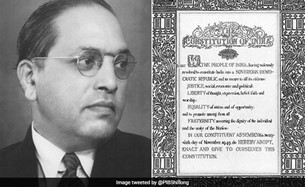
Sources:
The Non-Aligned Movement (NAM) @60
In News
NAM celebrates the 60th anniversary of the First Conference of Non-Aligned Countries.
Evolution of NAM
- Non-alignment was a policy fashioned during the Cold War, to retain autonomy of policy (not equidistance) between two politico-military blocs - the United States or the Soviet Union. The NAM provided a platform for newly independent developing nations to join together to protect this autonomy.
- It was a disparate group from many continents, with varying degrees of proximity to, and dependence on, one or the other bloc; and broadly united around NAM’s flagship campaigns for decolonisation, universal nuclear disarmament and against apartheid.
- The basic concept for the group originated in 1955 at the Asia-Africa Bandung Conference held in Indonesia.
- The first NAM Summit Conference took place in Belgrade, Yugoslavia, in September 1961 under the leadership of Josip Broz Tito of Yugoslavia, Gamal Abdel Nasser of Egypt, Jawaharlal Nehru of India, Kwame Nkrumah of Ghana, and Sukarno of Indonesia.
- Currently the NAM has 120 members. There are also 17 countries and 10 international organizations that are Observers at NAM.
- The purpose of the organization was enumerated in Havana Declaration of 1979 to ensure "the national independence, sovereignty, territorial integrity and security of non-aligned countries" in their struggle against imperialism, colonialism, neo-colonialism, racism, and all forms of foreign subjugation.

Goals and Achievements of NAM
- End Colonialism: The conferences of the NAM continuously supported the national liberation movements and the organisations that led those movements were given the status of full members in these conferences. This support greatly facilitated the decolonization process in Asia and Africa.
- End racial discrimination and injustice: It also condemned racial discrimination and injustice and lent full support to the antiapartheid movement in South Africa and Namibia. Today in both countries this obnoxious policy has ended with independence and majority rule.
- Preservation of peace and disarmament: Its espousal of peace, of peaceful co-existence and of human brotherhood, opposition to wars of any kind contributed to the lowering of Cold War tensions and expanded areas of peace in the world with fewer states joining military blocs. It also continuously strove for complete disarmament, under effective international control and for an end to the arms race.
- United Nations (UN) Reforms: The non-aligned states succeeded in altering the composition of the UN, voting reforms and consequently in changing the tenor of the interstate relation conducted through its organs. Non-alignment has facilitated third world's participation in world politics and in the process has democratized the international relations.
- Economic equality: The Developing and poor countries of South were perpetually dependent on the developed North for capital goods, finance and technology. In order to end this economic exploitation, termed as neocolonialism, the NAM called for a restructuring of the international economic and monetary systems on the basis of equality, non-discrimination and cooperation. This led to the establishment of a New International Economic Order (NIEO).
India’s Position in NAM
- India being a founder and largest member in NAM was an active participant in NAM meetings till 1970s but India’s inclination towards erstwhile USSR created confusions in smaller members. It led to the weakening of NAM and small nations drifted towards either US or USSR.
- Moreover, NAM continued losing relevance for India in a unipolar world, especially after the founding members failed to support India during crisis. For instance, during 1962 War with China, Ghana and Indonesia, adopted explicitly pro-China positions. During 1965 and 1971 wars, Indonesia and Egypt took an anti-India stance and supported Pakistan.
- Further disintegration of USSR led the unipolar world order dominated by US. India’s New Economic Policy and inclination towards US raised questions over India’s seriousness over non alignment.
- Post the end of the Cold war since the 1990s, India has attempted to build and repair its ties with the United States. The signing of a nuclear deal (the 123 Agreement of 2005) and 4 foundational agreements (GSOMIA, LEMOA, COMCASA and BECA), initiation of the ‘2+2’ dialogue, expanding bilateral economic relationship, formation of the Quad in the Indo-Pacific purportedly to contain China have all contributed to solidifying this strategic partnership.
- In 2019, the then foreign secretary acknowledged this shift in India’s position, and stated that India had “moved on from its non-aligned past” and that India became “an aligned state - but based on issues”.
- Prime Minister of India skipped the 17th and 18th NAM summit held in 2016 and 2019. 2016 was only second such instance when Head of a state didn’t participate in NAM conference.
- In 2020, India’s External Affairs Minister said that non-alignment was a concept of relevance in a specific era and a particular context. However, during the COVID period, in May 2020, India’s Prime Minister attended the virtual NAM summit and also called NAM the “world’s moral voice”.
Challenges for NAM
- Current Challenges facing the NAM include the necessity of protecting the principles of International law, eliminating weapons of mass destruction, combating terrorism, defending human rights, working toward making the United Nations more effective.
- Alliances in the Asia-Pacific face a bigger definitional dilemma. They were originally forged to deter the USSR. The threat to the alliance partners today is from an assertive China, which they are reluctant to define as a strategic adversary, because of their economic engagement with it and the huge military asymmetry.
- Moreover, NAM has increasingly become ineffective in certain other areas, particularly in tackling new and emerging challenges. This is primarily due to the tendencies of some NAM members to deliberately take up divisive issues, or to use NAM platform for bilateral score-settling, thereby creating division.
Post-COVID Crisis Leadership and relevance of NAM for India
Among the 120 permanent members of the NAM, India is perfectly positioned to emerge as the group’s leader owing to its democratic values and the size of its population and economy. Further, India’s credentials as one of the founding countries of the NAM, alongside Egypt and erstwhile Yugoslavia, also act in its favor.
- For India, leading the NAM has a dual advantage.
- First, taking a leadership role in the world’s largest multilateral organization is strategically important for the country to counter the authoritarian and nationalist image on the international platform.
- Second, as the world expects the emergence of a new global order in the aftermath of COVID-19, emerging middle powers like India are set to play an important role. India has identified this during the latest NAM summit, in which Prime Minister acknowledged the “limitations of the existing international system” and pitched a “new template of globalization, based on fairness, equality, and humanity.
- Further, the rhetoric of a “new cold war” between the United States and China is gaining momentum. In the likelihood of such a scenario, the focus will be back on the NAM — a core collective of middle powers of the world — to play a balancing role. In all likelihood, New Delhi with its current position in the global world order would be keen to lead this middle power balancing through leadership of the NAM within the ambit of South-South cooperation.
Conclusion: The need of the hour is to call out for NAM’s revitalisation for it to be able to cater to the 21st Century needs of Third World countries more efficiently. That being said, India’s work on NAM 2.0: A Foreign and Strategic Policy for India in the 21st Century- is surprising but relevant as an attempt to refine the country’s foreign policy with an amalgamation of ‘soft’ and ‘hard power’ so that either could be applied with full confidence. Each stakeholder must come forward and contribute to the success of NAM 2.0 so that South-South Development gets the acceptance and appreciation it deserves.
Sources:
- Statement by Minister of State for External Affairs
- The Non-Aligned Movement (NAM)
- History and Evolution of Non-Aligned Movement
- Reshaping the Non-Aligned Movement: challenges and vision
- UNIT 8: NON-ALIGNED MOVEMENT
- Is Non-Alignment Movement Still Relevant?
- WHY NAM IS STILL RELEVANT TODAY
- Non-Aligned Movement in The 21st Century: Relevant or No?
- What is in a NAM and India’s alignment
- Revisiting the Birthplace of Non-Aligned Movement
- 60 YEARS OF NAM
- NAM at 60 marks an age of Indian alignment
- Is NAM still significant for India?
- India isn’t really ‘non-aligned’ and doesn’t fit with NAM, which has no relevance today
- The Non-Aligned Movement and the Reform of International Relations
- Modi’s tryst with NAM
- Modi had turned his back on NAM and SAARC. Covid brings them back on his table
- Non-Aligned Movement (NAM)
- India’s Renewed Embrace of the Non-Aligned Movement
- India, the Non-Aligned Movement (NAM), and the Post-COVID World
Sustainable floating city
This is image of world's first sustainable floating city prototype, which will be built off the coast of South Korea's Busan by 2025. The Busan Metropolitan City of the Republic of Korea, UN-Habitat and OCEANIX have signed an agreement to build this city. It will be a collection of hexagonal platforms perched on top of water. This city could resist a category-five hurricane and its human-made islands will rise with the sea to avoid flooding. It'll be self-sufficient in food, energy and water. Sea level rise is a formidable threat, but sustainable floating infrastructure can help solve this looming catastrophe. The floating city will have ‘fully integrated zero waste closed-loop systems’ and be able to ‘organically transform and adapt over time’ to support a neighbourhood of anywhere from 300 to 10,000 residents.
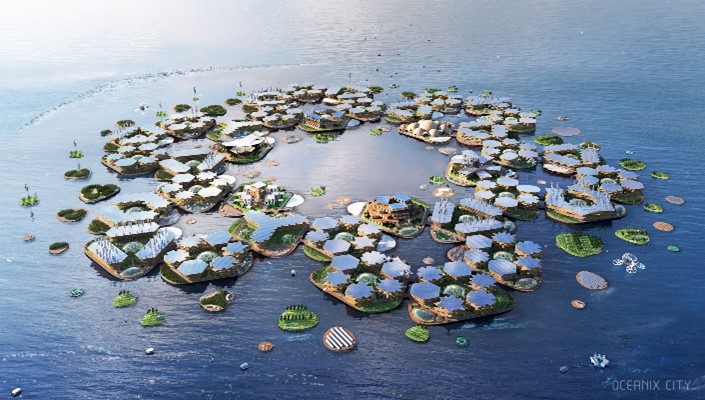
Sources:
Radio-Collaring
- Context: A wild elephant was recently radio-collared for the first time in Assam.
- Radio collars are GPS-enabled collars that can relay information about an elephants’ whereabouts.
- They weigh roughly 8 kg and are fitted around the elephant’s neck.
- According to a WWF collaring includes identifying a suitable candidate (generally an adult elephant), darting it with a sedative, and fitting a collar around the elephant’s neck, before the animal is revived.
- An accelerometer is also attached to the collar to “understand what exactly an elephant is doing at any given time (running, walking, eating, drinking, etc)”.
- Information from the GPS could thus help
- To track and study the movement patterns of the herd across regions and habitats, frequent corridors they move across, if the habitat needs protection or not etc to understand the driver of conflict.
- The collars act as an early warning system, to prepare the people and help them mitigate conflicts.

Source:
- Explained: Can elephant collaring help manage human-elephant conflict in Assam?
- Explained: Can elephant collaring help manage human-elephant conflict in Assam?
Image Source:
Trade Emerge Portal
- Context: ICICI Bankhas announced the launch of Trade Emerge platform
- Trade Emerge is an online platform that aims to offer digital banking services and value-added services to exporters and importers across India.
- It aims to make cross border trade hassle-free and convenient, as it eliminates the need for companies to coordinate with multiple touchpoints and decongests the time-taking physical procedures by making them more efficient and productive.
- The banking services include current/saving account offerings, comprehensive trade services (Letter of Credit, Bank Guarantee, Trade Credit etc.), Corporate Internet Banking payment and collection solutions and credit cards etc.
- The value-added services include incorporation of trade business, access to global trade database of nearly 15 million buyers and sellers across 181 countries, verification reports of potential customers etc through reputed credit bureaus, logistics solutions for shipment booking and last mile tracking, and insurance services like marine insurance all available online through a single window.

Source:
- ICICI Bank launches online platform to help Indian exporters
- ICICI Bank unveils Trade Emerge portal for exim trade
Image Source:
'Sentient Beings'
- Context: The UK government has declared octopuses, crabs and lobsters as “sentient beings”.
- Sentience is defined as having "the capacity to have feelings, such as feelings of pain, pleasure, hunger, thirst, warmth, joy, comfort and excitement."
- Animal sentience/consciousness, or animal awareness is the quality or state of self-awareness within a non-human animal, or of being aware of an external object or something within itself.
- The UK government had said that there is strong scientific evidence that decapod crustaceans and cephalopod molluscs are sentient.
- It further stated that lobsters and crabs shouldn't be boiled alive and also suggested best practices for their transport, stunning and slaughter.
- Vertebrates - animals with a backbone - are already classified as sentient under its legislation.

Source:
- UK classifies crabs, lobsters as 'sentient beings' after report says then can experience pain
- Octopuses, crabs, and lobsters will be recognized as 'sentient beings' in UK after a review concluded they feel pain and distress
Image Source:
Wage Rate Index (WRI)
- Context: Union Ministry of Labour recently released a new series of Wage Rate Index (WRI) with base year 2016.
- It is being compiled and maintained by the Labour Bureau, an attached office of the ministry.
- The new series of WRI with base 2016=100 will replace the old series with base 1963-65.
- The revised base will be more representative and play a critical role in determining the minimum wages and national floor wages along with other parameters.
- Of the 37 industries covered in the new series, 16 new ones — including textile garments, footwear and petroleum — have been added to the new basket.
- Wage Rate Index Number measures the relative changes in wage rates over a period of time, high or low Wage Rate Index in an industry does not necessarily indicate high or low wage rate in that industry as compared to other industries.

Sources:
Will States toe Centre’s line on Capex?: HBL
Essence: The article emphasizes on the importance of capital expenditure in the economy. Moreover, it emphasis on the capex of the states which have a higher multiplier effect than that of the Centre. But certain behavioral changes is needed to realize it full potential as the capex done by the states is not uniformly spent throughout the year but is bunched up and spent in the last quarter of the fiscal. Also, by the virtue of fiscal federalism States are allowed to prioritize revenue expenditure and asset creation happens towards the end of the fiscal.
There is also need to understand the reluctance of states w.r.t. capex spending. The states have been reluctant in spending to fear of the third wave of Covid-19. So, the article emphasizes on behavioural change on how capex is spent. If India aspires for expansion and double-digit economic growth it should spend on roads, power plants, ports and airports that generate better multiplier effect than investing in buildings.
Why you should read this article?
- To understand the importance of capital expenditure for an economy.
- To understand the difference in the nature of capital expenditure done by states and by center.
- To get a brief insight in the Center’s attempt to bring about a behavioral change on how capex is spent.
Source:
Setting the tone at Glasgow, the job ahead in Delhi: TH
Essence: The article sets the tone for achieving the aim that India has pledged for in Glasgow that is to reach net zero emissions by 2070. The article also discusses the need for Climate justice, as put forth by India at Glasgow. The article stresses on the immense focus of developed world on Phasing out coal, while not even mentioning the burning issue of fuel oil.
If India aspires for it, using the cleaner energy alone will not suffice, a change in the behaviour of people that would lead to change in consumption pattern is also needed. A change that would bring shift from using carbon intensive good and services to cleaner sources, from processed food to a seasonal plant-based diet is needed. Last but not the least would be achieving a’ more equitable distribution of wealth with a minimum level of prosperity and affordable energy use for all.
Why you should read this article?
- To understand the intention of India behind pledging Net-zero by 2070
- To understand that shifting alone to renewable energy will not lead to achieve the net zero emissions by 2070.
Source:
Ambedkar’s constitutionalism speaks to contemporary times: HT
Essence: On National Constitution Day, the article focusses on various ideas by Dr.B.R. Ambedkar. Ambedkar’s writings, speeches, social movement and public and political engagements make us aware of his ideas of Constitutionalism and his firm believe in the protection of minority rights. His idea of Constitutionalism involved principles of liberty, equality and fraternity (which according to him was another name of democracy). His writings and speeches reflect that responsive government as an institution of social reform and democracy as an attitude of respect towards the followers were at the core of constitutionalism. Thus, he advocated that Constitutional drafting should be not just a political process. As a strong proponent of Constitutional traditions and practices he also gave lot of priority to even the post of Leader of Opposition.
The idea of representation laid the basis of representation of lower classes. This in fact was due to his reading of global history. He was a strong believer in minority rights and that there should be no tyranny of the majority over minority. He pushed the threshold of Constitution to include rights of Schedule Castes. Finally, he advocated for kindness in governance and constitutionalism as a reflection to contemporary society.
Why should you read this article?
- To know the relevance of Ambedkar in Constitutional development, his ideas and his struggle for the protection of minority rights.
- To understand certain core values revolving around constitutionalism.
- As Ambedkar and his contribution is an important topic to study in GS I (Personalities in Modern Indian History) and the idea of constitutionalism is an important topic in GS II. They find relevance in Essay and Ethics ( GS IV) too.
Source:
Chhota Masterji’s Bal Choupal
Background
- Deeds of a person cannot be gauged on the basis of their age.
- Anand Krishna Mishra, known as Chhota Masterji for the underprivileged slum kids in Lucknow, has proven that ‘Age is just a number’

How Bal Choupal an becoming an inspiration?
- When kids at the age of 12 are busy with playing video games and watching cartoons, Anand started an initiative for the underprivileged kids named Bal Choupal.
- Fondly called as Chhota Masterji, he is currently studying in VII standard and hails from Lucknow.
- He went around to teach in about 125 villages and towns in and around Lucknow.
- The initiative started in 2012, where he used to teach the kids about what he had learned in his school.
- Today he teaches mathematics, computer science and English to about 700 children.
Quote: Give a man a fish and you feed him for a day; teach a man to fish and you feed him for a lifetime. - Maimonides
Source:
Share the article
Get Latest Updates on Offers, Event dates, and free Mentorship sessions.

Get in touch with our Expert Academic Counsellors 👋
FAQs
UPSC Daily Current Affairs focuses on learning current events on a daily basis. An aspirant needs to study regular and updated information about current events, news, and relevant topics that are important for UPSC aspirants. It covers national and international affairs, government policies, socio-economic issues, science and technology advancements, and more.
UPSC Daily Current Affairs provides aspirants with a concise and comprehensive overview of the latest happenings and developments across various fields. It helps aspirants stay updated with current affairs and provides them with valuable insights and analysis, which are essential for answering questions in the UPSC examinations. It enhances their knowledge, analytical skills, and ability to connect current affairs with the UPSC syllabus.
UPSC Daily Current Affairs covers a wide range of topics, including politics, economics, science and technology, environment, social issues, governance, international relations, and more. It offers news summaries, in-depth analyses, editorials, opinion pieces, and relevant study materials. It also provides practice questions and quizzes to help aspirants test their understanding of current affairs.
Edukemy's UPSC Daily Current Affairs can be accessed through:
- UPSC Daily Current Affairs can be accessed through Current Affairs tab at the top of the Main Page of Edukemy.
- Edukemy Mobile app: The Daily Current Affairs can also be access through Edukemy Mobile App.
- Social media: Follow Edukemy’s official social media accounts or pages that provide UPSC Daily Current Affairs updates, including Facebook, Twitter, or Telegram channels.

